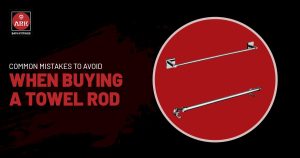Choosing the right towel rod for your bathroom might seem like a simple decision, but it’s surprisingly easy to make mistakes that can impact both the functionality and aesthetics of your space. A poorly chosen or installed towel rod can lead to daily frustrations, wasted money, and even damage to your bathroom walls. To ensure you get the most value and performance from your purchase, here are the most common mistakes to avoid when buying a towel rod.
Overlooking Bathroom Size and Layout
One of the most frequent mistakes is failing to consider the size and layout of your bathroom before selecting a towel rod. A rod that’s too large can overwhelm a small bathroom, making it feel cramped and cluttered. Conversely, a rod that’s too short in a spacious bathroom may look awkward and provide insufficient hanging space. Always measure your available wall space and visualize how the rod will fit with your bathroom’s layout. Placement is equally important—installing the rod too close to the shower or too far from reach can result in damp towels and inconvenience. Take time to plan the ideal spot, ensuring it’s within easy reach of the shower or bathtub for maximum usability.
Read more: Why Every Bathroom Needs a Double Towel Rod – Top Benefits
Choosing the Wrong Length
Selecting a towel rod that doesn’t accommodate your towels is a common oversight. If you use large bath towels, make sure your rod is at least 24 inches long to allow towels to hang flat and dry properly. For hand towels or smaller bathrooms, a shorter rod may suffice. Always match the rod length to the size of your towels and the number of users in your household. This small detail can make a big difference in everyday convenience.
Skimping on Quality for a Bargain
It’s tempting to choose the cheapest towel rod available, but this often leads to disappointment. Low-quality rods are more likely to rust, lose their finish, or become unstable over time, especially in the humid environment of a bathroom. Investing in a durable, well-made towel rod pays off in the long run. Look for rods made from corrosion-resistant materials like stainless steel, brass, or high-quality aluminum. These options not only last longer but also maintain their appearance, keeping your bathroom looking fresh and stylish.
Ignoring Style and Finish
A towel rod is more than just a functional accessory—it’s also a part of your bathroom’s overall design. Choosing a rod that clashes with your existing fixtures or décor can disrupt the visual harmony of the space. Consider the finish and style of your faucets, showerheads, and cabinet hardware when selecting a towel rod. Whether you prefer modern chrome, classic brushed nickel, or bold matte black, make sure your choice complements the rest of your bathroom for a cohesive look.
Read more: What Waste Coupling Is Used in Water Closet?
Overlooking Wall Structure and Mounting Hardware
Another common mistake is failing to account for the type of wall where the towel rod will be installed. Drywall, tile, and plaster each require different mounting hardware to ensure a secure installation. Using the wrong anchors or screws can result in a rod that wobbles, pulls out, or damages the wall. For drywall, invest in high-quality wall anchors rather than relying on the cheap ones often included in the package. For tile or masonry, use appropriate drill bits and anchors to prevent cracks and ensure stability. A securely mounted rod not only lasts longer but also prevents accidents and wall damage.
Neglecting Durability and Maintenance
Your towel rod will face daily use and exposure to moisture. Choosing a rod that isn’t built to withstand these conditions can lead to premature wear, rust, or corrosion. Select rods with protective coatings or finishes designed for wet environments. Additionally, consider how easy the rod is to clean—models with simple lines and minimal crevices are less likely to accumulate grime and are easier to maintain.
Not Checking for Damage Before Installation
It’s easy to overlook the importance of inspecting your new towel rod before installing it. Even minor dents, scratches, or defects can compromise the rod’s performance and longevity. Damaged rods are more susceptible to rust and may not hold up under regular use. Always check for any visible flaws before installation, and contact the retailer for a replacement if necessary. This quick step can save you from future headaches and ensure your rod functions as intended.
Read more: How to Connect Waste Coupling in Sink: Step-by-Step Guide
Failing to Consider User Needs
Different households have different needs. For example, a single towel rod may suffice for a guest bathroom, but a family bathroom might benefit from a double rod or multiple rods for added capacity. Think about how many towels you need to hang and who will be using the bathroom. This consideration ensures everyone has enough space for their towels, reducing clutter and improving organization.
Incorrect Placement and Leveling
A towel rod that isn’t installed level can be both unsightly and impractical. Take the time to use a proper level during installation—eyeballing it is rarely accurate. A crooked rod not only looks unprofessional but can also cause towels to slide off. Additionally, avoid placing the rod too high or too low. The ideal height is typically around 48 inches from the floor, but adjust this based on your household’s needs and the location of other fixtures.
Overtightening or Undertightening Brackets
When installing your towel rod, it’s crucial to secure the brackets properly. Overtightening can crack plastic or metal components and even damage your walls, especially if they’re made of drywall or tile. On the other hand, undertightening can result in a loose rod that wobbles or pulls out over time. Tighten the brackets just enough to hold the rod securely without causing damage, and always double-check your work before hanging towels.
Forgetting About Future Adjustments
Sometimes, you may need to adjust or move your towel rod in the future. When installing, make sure that screws and brackets are accessible and not blocked by other fixtures or tiles. This foresight will make any future changes or repairs much easier and prevent unnecessary wall damage.
Conclusion
Buying a towel rod may seem straightforward, but avoiding these common mistakes will ensure you end up with a fixture that’s functional, durable, and visually pleasing. Take time to assess your bathroom’s size and layout, invest in quality materials, match the style to your décor, and install the rod securely with the right hardware. By considering your household’s needs and planning for the long term, you’ll enjoy a clutter-free, organized, and stylish bathroom for years to come.
Read more: How to Fix Wash Basin Waste Coupling












